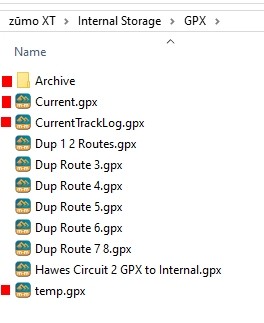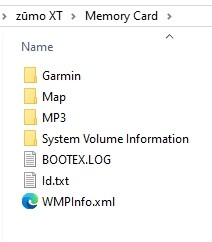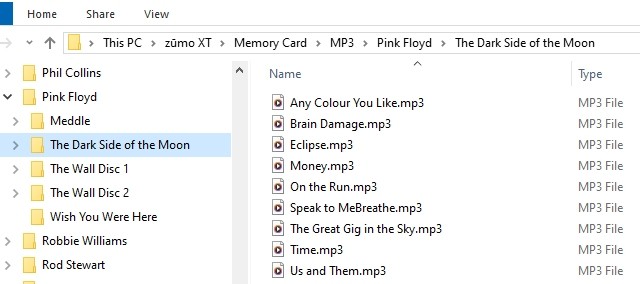Many thanks for the comments - oh and welcome to the forums.
I've taken the liberty of adding the hyperlink the page that you refer to (Moderator privilege).
The first thing to say is that the pages that you are looking at refer to the XT. I have never set eyes or hands on an XT2, but I have read the manual and it seems as though much of the XT has transferred. But I know too well from the development of the 590, 595 and the XT (all of which I still have), that they are not the same beast.
That being said, I would be very surprised if the pages on the XT are that far wide of the mark for the XT2, and extremely surprised if the folder structure has changed. The images below may have been shrunk down by the system. Click on the image if you want to see it in its normal resolution.
Internal Storage
The Root Folder.

- Internal 1.jpg (18.96 KiB) Viewed 4783 times
The image shows the main subfolder names.
.System isn't always visible - you have to make it visible if you want to see it. But that is a separate thing from what you want to know at present. It is normally hidden becasue it contains the system folders which generally speaking could prevent your Zumo from working if they are messed around with.
The two folders of interest to us at the moment are Garmin and GPX. I have images with examples in the next two sections.
You might also notice a folder called MP3. That isn't there by default, you have to create it if you want mp3 files to be stored in Internal Storage. In fact, I don't - I put it there to test something out and forgot to delete it ! But if you want music files there, that is where you need to put it. On the XT it doesn't matter whether you call it MP3 or mp3 - but on some Zumos it has to be in upper case.
Root Folder / GPX

- Internal 2.jpg (19.96 KiB) Viewed 4784 times
This shows the content of my GPX subfolder. It may or not be there already. If you transfer data from Basecamp, the system will put it there. If you create a route using trip planner on the Zumo, it will put the GPX folder there. Otherwise you have to create the folder yourself. It has to be galled GPX (capital letters are what I have always used, so I do not know if gpx in lowercase works.)
The 4 entries that have a red box next to them are put there by the system. The others are GPX files that I have placed in there. These are some test routes that I created to test XT behaviour. Each of them contains routes, saved waypoints/favourites and tracks.
CurrentTrackLog.gpx
...is a record of your recent riding activity - stored as tracks which record where you have been, the date, time and speed at locations that are plotted anywhere between 1 and 20 seconds apart - depending on how straight the road is. This can be really useful if you like to keep these as a record of where you have been and when. I do.
Archive
This is created automatically by the system and will appear only after you have ridden a few days with your Zumo. When the CurrentTackLog.gpx file becomes full, the Zumo will take some of the older tracks and save them as a numbered file in the Archive Folder. Starting at 1.gpx. When 1.gpx gets to be about 1MB, it will start a new file called 2.gpx and so on. Every few months I will copy all of the files in Archive to my hard drive - overwriting any that I have previously downloaded. This is because the XT keeps updating some of the archive files in an attempt to keep complete tracklogs together. That way I am sure to get the last version of the file on my system.

- Internal 3.jpg (41.23 KiB) Viewed 4784 times
The third image shows the contents of my Archive folder. Typically it would keep the last 20 files, but for whatever reason it has got only the archives from 19 to 27 - ie the last 9. I don't know why that is. The m-m icon that is associated with the gpx files is to do with my computer. Typically I open GPX files with a program called Memory-Map, because I like to see my routes on a properly drawn high resolution Ordnance Survey map - the sort that is used by hikers and emergency services.
Current.gpx
This is a file that contains all of the routes, tracks and saved location / Favourites that are currently available from the Zumo screen.
temp.gpx
Is a file that is used by Basecamp to temporarily store data (routes, tracks and Waypoints/Favourites) that has been transferred from Basecamp.
This file will be overwritten by subsequent transfers. Tracks are deleted from the file once they have been imported. Once imported it must be assumed that you may not be able to import them again - if say you deleted a route from the XT.
Position.gpx
Mine does not show a Position.gpx. I do not know why. My Zumo must have reset in a recent update ?? This is a simple file that records the position of the zumo the last time that it got a signal. It assumes that when you turn on the stanave you will be in the same position and that speeds up the process of getting a fix on the satellites. If you change position by a long way (like you caught a ferry or a plane), then it may take up to 3 minutes to find out where you are. In order to find out where you are it needs a few satellites. In order to find the satellites that are overhead, it needs to know where you are ! It gradually works it out - but it takes much longer.
SD Card
The Root Folder.
This shows the contents of my current SD card. The two folders that are of interest are Garmin and MP3, and I have screenshots below of each of these.

- SD Card 1.jpg (9.82 KiB) Viewed 4784 times
Memory Card / Garmin /GPX

- SD Card 2.jpg (30.38 KiB) Viewed 4784 times
The Zumo does not create a GPX folder - unless you transfer files from Basecamp. If you want to place your own GPX files onto the SD card, then they need to be in a GPX folder. (which may or may not be true on the XT2 - but it is a convention worth sticking with - especially since I don't know anything about the XT2).
In that folder you can place any gpx file that contains Waypoints (ie Saved Locations), tracks and routes. Any GPX file can contain any number of these, and they can be quite large in size. Name them as you like - the Zumo does not use the name of the file, so name them so that you recognise what they contain when you want to delete them.
The Zumo will not alter the contents of any gpx file that is saved on the SD card. (it does when the gpx file is placed in internal storeage.). So the SD card is a good place to put your gpx files. You can import the routes, tracks and Waypoints / Favourites into the Zumo. From the Zumo screen you can use the routes, tracks and waypoints. You can delete any route and it will still be there on the SD card for you to import again if you need to. The same applies to tracks and Waypoints.
It doesn't matter whether you have your routes all in one gpx file or whether you decide to store one route per file. The same applies to tracks. And to waypoints. And you could use one gpx file to store everything or (say) put your routes tracks and waypoint for one day all in one gpx file, and those for another day in a separate gpx file. it is up to you.
When I refer to 'waypoints', I am referring to the saved locations that will appear in 'favourites' on the Zumo. Any other type of point that is plotted as part of a route eg Via and Shaping points n- they will be part of the route and cannot be separated from it.
Memory Card / Garmin / MP3

- SD Card 3.jpg (39.85 KiB) Viewed 4784 times
Any MP3 file can be placed in this folder and in any subfolder folder that you care to create within that folder.
So I have arranged folders by Artist name / Album Name and in the album name folder are the tracks from the album.
The name of the album, artist, tracks have no relevance to the MP3 player in the Zumo. The zumo finds any mp3 file in any folder in any subfolder and lumps them altogether. It knows the album name, artist name , track name, track number from the tags that are recorded with the MP3 file. Programs like Windows Media Player will display and let you edit this information. I organise mine into folders like this to make it easier for me to find and delete individual mp3 files.
Phew. Can I go and lie down now please ? !